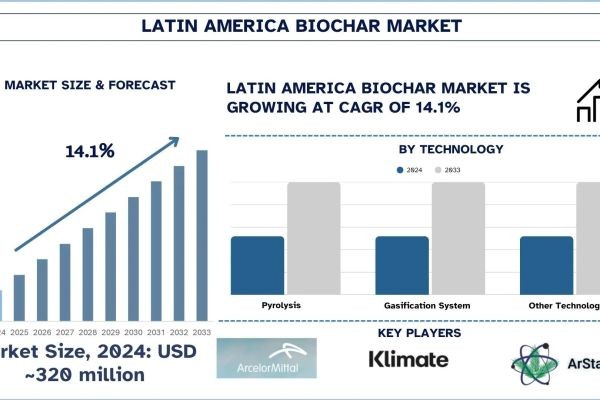According to UnivDatos, Soil regeneration and yield pressure in Agriculture and Regulated and voluntary carbon markets have boosted the demand for Biochar in Latin America. As per their “Latin America Biochar Market” report, the Latin America market was valued at USD 320 million in 2024, growing at a CAGR of about 14.1% during the forecast period from 2025 - 2033 to reach USD million by 2033.
The biochar market in Latin America is moving away from being a premium farm input towards an infrastructural necessity to manage waste, reduce carbon emissions, and rehabilitate soils. The diversion of landfills is being matched with decreasing methane, and governments and development banks are directing residues of farms, sawmills, and cities into approved biochar. Bankable projects are opening up with policy support and concessional money as MRV standards evolve. In the meantime, the tropical value chains are being industrialized: co-located reactors process cane bagasse, coffee husks, and timber byproducts into feedstock, and waste heat recovery enhances yields. Business offtakes and multiyear acquisitions make cash flows stable and facilitate project capital and plant networks in Brazil, Mexico, and Colombia.
Access sample report (including graphs, charts, and figures): https://univdatos.com/reports/latin-america-biochar-market?popup=report-enquiry
Residue-to-biochar programs gaining policy support:
Biochar is beginning to be recognized by governments and development agencies as an infrastructure solution, rather than a niche farm input, in Latin America. New city and regional initiatives direct the crop residues, pruning, and sawmill byproducts to certified biochar, matching the landfill diversion targets with soil restoration and carbon elimination. Public institutions are also testing biochar to landscape urban areas and rehabilitate post-fire areas, and agriculture ministries are testing co-funding models that provide equipment grants with technical assistance to cooperatives. Concessional finance is being provided by development banks and innovation agencies to de-risk early plants and results-based funding. With the standards of monitoring and permanence becoming more mature, the regulators are connecting the residue management, reduction of methane, and the issuance of carbon credits. What is obtained is a more straightforward route to waste management requirements for bankable biochar projects supporting food systems and cities.
In 2025, the Governing Board of the Integrity Council for the Voluntary Carbon Market (Integrity Council) approved the Climate Action Reserve US and Canada Biochar Protocol Version 1.0 as meeting its high-integrity Core Carbon Principles (CCP) and Mexico Forest Protocol Version 3.0 as CCP-approved pending remedial action.
Latest Trends in the Latin America Biochar Market
From pilots to industrial scale in tropical value chains:
Latin American biochar is no longer just a demonstration move to embedded capacity in large tropical supply chains. Co-locating a reactor in sugar cane mills, sawmills, and coffee processing centers allows the project developers to convert the residues to consistent feedstock instead of a logistics liability. Integrated designs couple continuous kilns with waste heat recovery to dry products, generating predictable amounts of output in the case of agricultural customers and carbon purchasers. Procurement teams are no longer conducting individual off-trial purchases but are moving to several-year purchase plans running next to harvest times and budgets of fertilizers. Supplier contracts are being constructed with quality standards, safety standards, and carbon accounting standards, enhancing bankability and decreasing scale-up. With the operators becoming reliable, cost curves becoming better, industrial partners now start to think of networks of plants in several states and countries, transforming tropical value chains into distributed biochar platforms.
Key Investment Trends:
The focus on biochar investment in Latin America has moved to project funding of industrial-scale plants. Capital focuses on biochar residue to platforms supporting policy-backed and sound feedstock contracts. Debt and equity are unlocked as a result of corporate offtakes and forward credit purchases, which de-risk cash flows. Investors prefer dual revenue models, which are soil amendment sales in addition to premiums in both regulated and voluntary markets. The low-cost residue aggregation and branding of a circular economy is facilitated through partnerships with tropical value chains. Funds give priority to measurable impacts and direct the money to projects with MRV and new methodologies. Consolidation, developer operator hybrids, and localized manufacturing should be expected.
Country Market Growth
Brazil is developing as the anchor market in Latin America with biochar due to the ample availability of sugarcane bagasse, timber residues, and municipal green waste. Continuous reactor developers are collocating mills with continuous reactors to obtain feedstock, recycle waste heat, and provide soil products to pasture and row crops. The additional revenue stream brought by the interest of corporate carbon buyers and the debate on the national carbon market and climate finance enhances the level of bankability. Engineered biochar is also being tested by early adopters in concrete and asphalt. The major limitations will be grid reliability in internal states, port logistics, and uneven permitting.
Click here to view the Report Description & TOC https://univdatos.com/reports/latin-america-biochar-market
“Investments Driving a Sustainable Biochar Future”
The Latin America Biochar market has been supported by increasing government policies as well as increasing focus from the agriculture sector. As the focus on sustainability in agriculture, animal farming, and industrial applications is extensively growing, the demand for the biochar market is further anticipated to rise in the coming years.
Related Report:-
Linear Alkyl Benzene Market: Current Analysis and Forecast (2025-2033)
Tetrahydrofuran Market: Current Analysis and Forecast (2025-2033)
Bio-based Elastomers Market: Current Analysis and Forecast (2025-2033)
Leak Detection Dye Market: Current Analysis and Forecast (2025-2033)
Redispersible Polymer Powder Market: Current Analysis and Forecast (2025-2033)
Contact Us:
UnivDatos
Contact Number - +1 978 733 0253
Email - contact@univdatos.com
Website - www.univdatos.com
Linkedin- https://www.linkedin.com/company/univ-datos-market-insight/mycompany/

